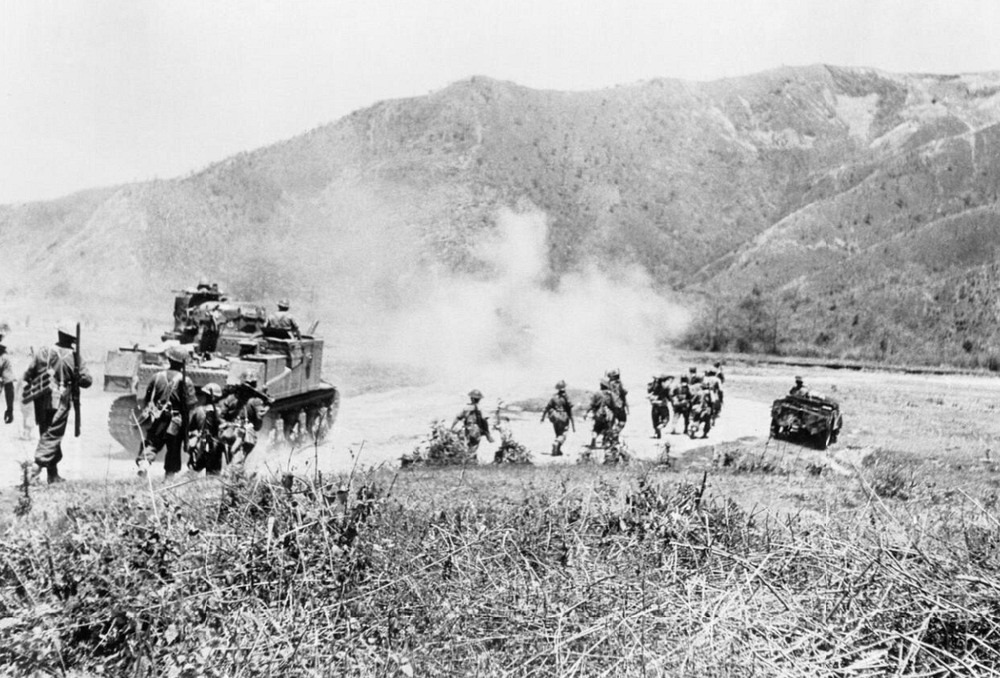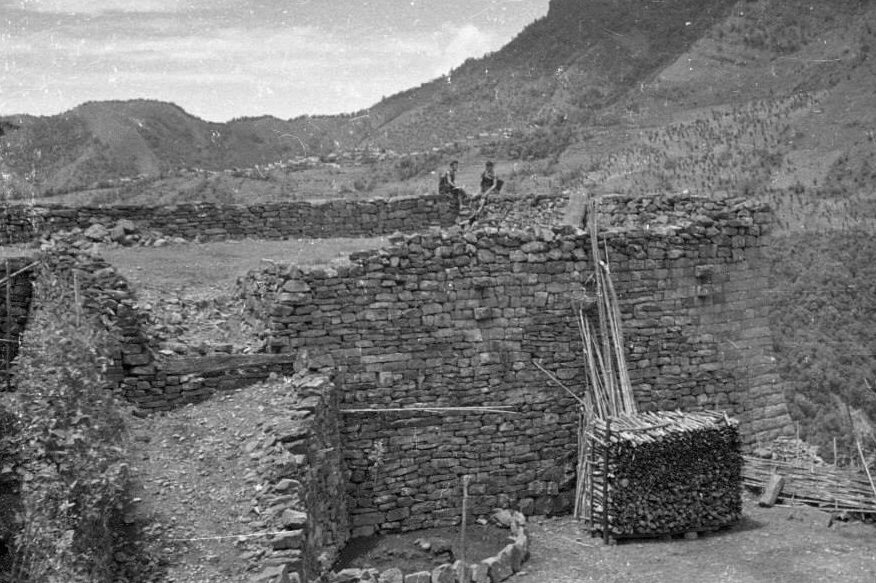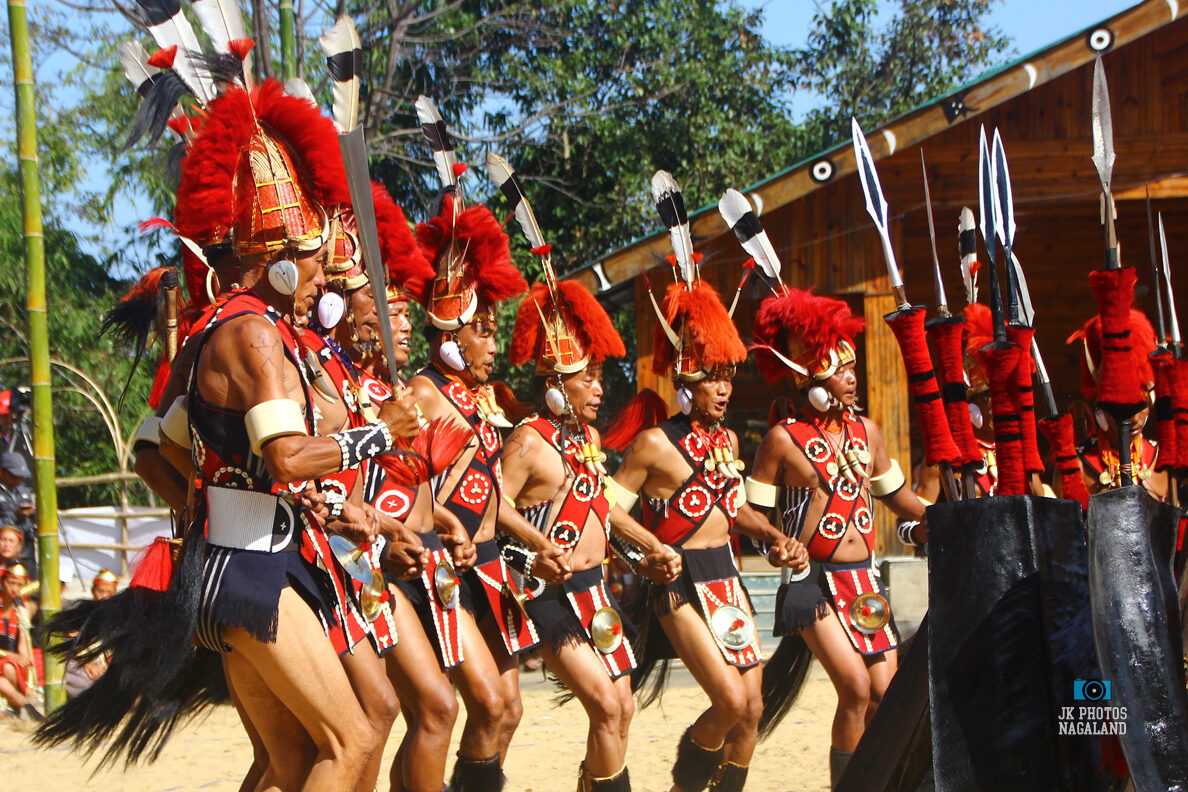The remote Naga lands was relatively unknown to the world until the coming of the British. Though the Nagas fought bravely against the British, the Nagas were no match for the mighty British. The British established it’s first headquarter in the Naga Hills at Samaguting in 1866. The British annexation continued deep inside Naga Hills. The battle of Khonoma also known as the last Naga resistance against the British was fought in 1879. By 1890 – 1900 entire Naga Hills came under the British Control.
Then, the World War II happened from 1939 to 1945, a part of which was also fought in Nagaland which is now known as “The Battle of Kohima“, which took place from 4 April to 22 June 1944.
During the Second World War, one of the most decisive battles in the ‘Burmese front’ took place at Kohima. It is reportedly one of the fiercest close quarter battle which took place. The battle has been referred to by some authors such as Martin Dougherty and Jonathan Ritter as the “Stalingrad of the East“. Military historian Robert Lyman said that the battle of Kohima and Imphal “changed the course of the Second World War in Asia..“.
The WWII put Nagaland on the World map. A famous World War II cemetery is located right in the middle of Kohima to remember the fallen soldiers of both sides.

BATTLE OF KOHIMA
Background: On 7 December 1941, the Japanese attacked the US naval base at Pearl Harbour and later declared war on Britain and the United States. Subsequently, the Japanese invaded European colonies across East Asia, including the British territories of Hong Kong, Malaya, Singapore and Burma.
In March 1944, the Japanese 15th Imperial Army began an advance against India’s north-east frontier to stall a planned British invasion of Burma. The Japanese plan was to capture the British supply bases on the Imphal Plain and cut the road linking Dimapur and Imphal at Kohima.
The Japanese plan to invade India, codenamed ‘Operation U-Go Offensive’, was originally intended as a spoiling attack against the British IV Corps at Imphal in Manipur, to disrupt the Allied offensive plans. However, the commander of the Japanese Fifteenth Army, Lieutenant General Renya Mutaguchi, enlarged the plan to invade India itself and perhaps even overthrow the British Raj. Part of the plan involved sending the Japanese 31st Division to capture Kohima and thus cut off Imphal, …and further push the 31st Division on to Dimapur, the vital rail head and logistic base in the Brahmaputra River valley. [Allen, Louis (2000) [1984]. Burma: The Longest War 1941–45. London: Phoenix Press]
Japan invaded India in early 1944. Two Divisions of the 15th Imperial Japanese Army i.e. the 33rd and 31st Division commanded by Lieutenant–General Renya Mutaguchi, crossed the Chindwin River and moved towards Imphal. The 33rd Division marched into India through Manipur while the 31st Division trekked through the jungles of Burma (Now Myanmar) and set up camps in the Eastern Angami (Now Chakhesang) and Southern Angami areas by early April 1944. The Japanese’ 31st Division, sent to attack Kohima, was led by Lieutenant-General Kotoku Sato (1893-1959). Lieutenant-General Kotoku Sato’s 31st Division task was to surround Kohima to prevent any relief from Dimapur and cut of Imphal.
A road running through the Kohima ridge connected the British supply base at Dimapur and Imphal in the south, through the town of Kohima. From Imphal, the road proceeded further south into Burma. This was the route passing through Kohima which the Japanese intended to capture to cut of supply lines and to further push inside India capturing bases.
The battle took place in three stages from 4 April to 22 June 1944 around the town of Kohima, now the capital of Nagaland in northeast India.
1) From 3 April to 16 April 1944
- The Japanese attempted to capture Kohima ridge, a feature which dominated the road by which the British and Indian troops of IV Corps at Imphal were supplied.
2) From 18 April to 13 May 1944
- British and Indian reinforcements counter-attacked to drive the Japanese from the positions they had captured. The Japanese abandoned the ridge at this point but continued to block the Kohima–Imphal road.
3) From 16 May to 22 June 1944
- Tthe British and Indian troops pursued the retreating Japanese and reopened the road.
Kohima surrounded
The Japanese offensive started well. On 29 March, they cut the Imphal-Kohima road. The first contact between the Allied troops and the Japanese army took place at Aradura, Kohima on 4th April 1944. By 5th April 1944, Kohima was surrounded by the Japanese force. When the war broke out, the Japanese Army numbering more than 10000 men slowly encircled Kohima and established posts in the Kohima Village, Treasury Hill (now D.C’s Office), Jail Hill (now D.G.P. Office), GPT Ridge (now Japfü Hotel).
Colonel Hugh Richards hastily organised a scratch force from his 2,500-strong garrison, many of whom were non-combatants. The force comprised of the 4th Battalion, The Queen’s Own Royal West Kent Regiment and the Assam Regiment. Elements of 161st Indian Brigade, stationed at Jotsoma, also reinforced the Kohima defenders. The Allied troops were slowly pushed up towards the Garrison Hill (now Raj Bhavan) into a perimeter less than half of a football ground. Fierce close quarter battles were fought around the D.C.Bungalow (now Kohima War Cemetery) and the Tennis Court area.
The Allied force who numbered lesser than 1000 were surrounded from all sides on the Garrison Hill. There was shortages of ammunition and food supply as the only road from Dimapur to Kohima was cut off by the Japanese just outside Zubza. Many non-combatants (clerks, drivers, cooks) had to take up rifle to defend themselves. The valiant soldiers could withhold the onslaught of the heavily numbered forces for 13 days. Stories of hand to hand combat around the Tennis Court and D.C. Bungalow areas have been told in war stories of the Battle of Kohima. Field Marshall William Slim once wrote that the Battle of Kohima would go down in the History of World War II as ‘the bloodiest battle’.
Meanwhile, the 2nd Division of the British Army managed to advance to Kohima from Dimapur. They finally reached Kohima on the 18th April 1944 bringing much relief to the Allied forces who were now on the verge of being defeated by the Japanese. The 2nd Division slowly drove away the Japanese forces from in and around Kohima. The Japanese forces finally had to retreat back to Burma because of the strong pursuit by the Allied forces.
The casualties on both sides were very heavy. In the Kohima War Cemetery lies buried the gallant defenders of Kohima. There are 1421 graves of brave soldier who fought at the Battle of Kohima at the Kohima War Cemetery. There are 2 Victoria Cross holders, the highest decoration of the British Army buried in Kohima War Cemetery.
At the bottom of the Kohima War Cemetery is the memorial of the 2nd Division with the names of the soldiers who gave their lives in the Battle of Kohima inscribed on stone panels. The famous epitaph on the memorial says:
“When you go home, tell them of us and say, for your tomorrow we gave our today”.
The battle of Kohima ended on 22 June 1944 when British and Indian troops from Kohima and Imphal met at Milestone 109, ending the Siege of Imphal.
Key Facts of Battle of Kohima:
- The Battle of Kohima happened between: 4 Apr 1944 – 22 Jun 1944
- Result: Allied victory
- Key Commanders and leaders in the Battle of Kohima
- Japan: The 31st Division to Kohima, was led by Lieutenant-General Kotoku Sato (1893-1959).
- Colonel Hugh Richards commanded the 2,500-strong Kohima garrison.
- Lieutenant-General Montagu Stopford (1892-1971) led 33rd Corps, which relieved Kohima and Imphal.
- Casualties: British and Indian troops lost more than 4,600 men while the Japanese lost more than 5,700
In 2013, the British Army Museum voted the Battle of Kohima and the Battle of Imphal (seen as one overall battle) “Britain’s greatest battle.” ahead of the more celebrated events such as D-Day and Waterloo.
The troops who fought in India and Burma in World War II called themselves “The Forgotten Army”.
# Battle of Kohima #World War II in Kohima # Kohima War Cemetery #Stalingard of the East # Battle of the Tennis Court
PREVIOUS:
- History #1 – The Naga People
- History #2 – Origin of the Word ‘Naga’
- History #3 – Migration of The Nagas
- History # 4 – The Nagas and the Ahoms
- History # 5 – The Nagas during British Rule
- History # 6 – Battle of Khonoma
- History # 7– Formation of Naga Hills
Recommended Reading:



Leave a Comment (FB)